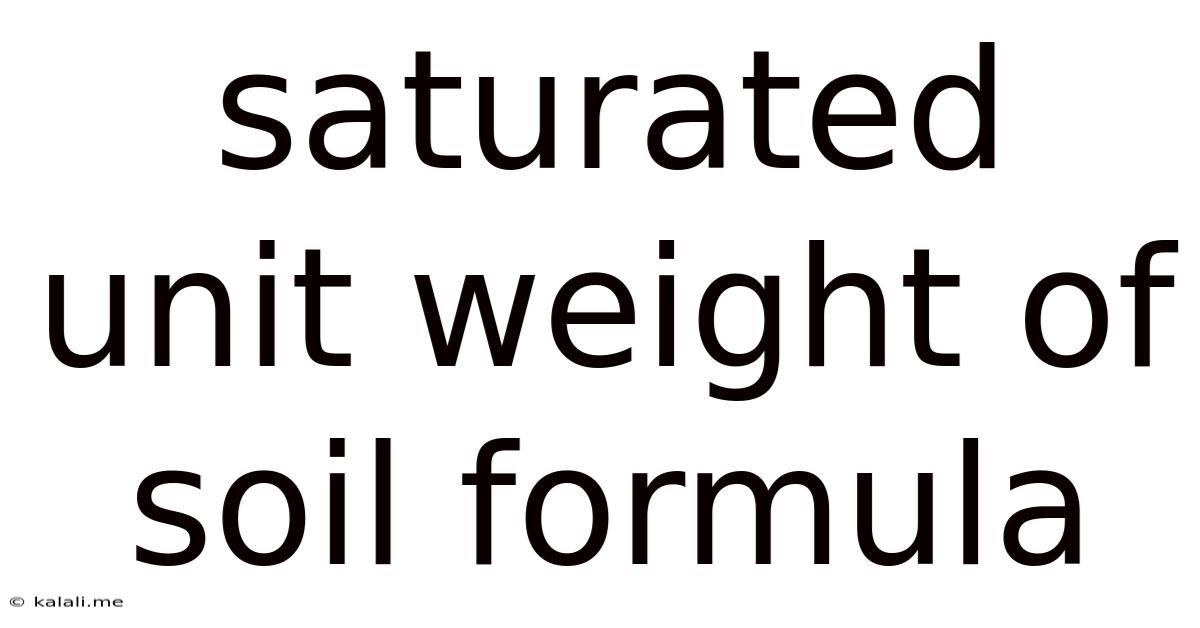Saturated Unit Weight Of Soil Formula
Kalali
Jun 12, 2025 · 3 min read

Table of Contents
Understanding and Calculating the Saturated Unit Weight of Soil
Determining the saturated unit weight of soil is crucial in various geotechnical engineering applications, including slope stability analysis, earth dam design, and foundation engineering. This article will delve into the definition, significance, and calculation of the saturated unit weight, providing you with a comprehensive understanding of this important soil property. Understanding this will allow you to accurately assess the engineering properties of soil samples.
The saturated unit weight of soil (γ<sub>sat</sub>) represents the weight of soil per unit volume when the voids are completely filled with water. This contrasts with the dry unit weight (γ<sub>d</sub>), which considers only the weight of soil solids, and the buoyant unit weight (γ' or γ<sub>sub</sub>), which accounts for the upward buoyant force of water. Accurate calculation is paramount for reliable geotechnical estimations.
What is Saturated Unit Weight?
The saturated unit weight is a fundamental soil parameter indicating the density of soil when completely saturated. It reflects the total weight of both soil solids and the water within the soil pores. This value is higher than the dry unit weight because it includes the weight of the water. Knowing this weight is essential for assessing the stability of structures built on or within the soil. This is particularly important in geotechnical assessments for projects involving foundations, embankments, and other earthworks.
Formula for Calculating Saturated Unit Weight
The saturated unit weight (γ<sub>sat</sub>) can be calculated using several methods, primarily relying on the following fundamental formula:
γ<sub>sat</sub> = (W<sub>total</sub>) / V
Where:
- γ<sub>sat</sub> = Saturated unit weight (kN/m³ or lb/ft³)
- W<sub>total</sub> = Total weight of the saturated soil sample (kN or lb)
- V = Total volume of the saturated soil sample (m³ or ft³)
This formula is straightforward, but obtaining accurate measurements of W<sub>total</sub> and V is critical for precise results. Laboratory testing procedures, such as the water content determination and specific gravity tests, are essential for acquiring these values.
Alternative Calculation Methods
While the above formula is the most direct, other methods utilizing readily available soil parameters can also be used to calculate the saturated unit weight. These include:
-
Using Dry Unit Weight and Water Content: This method is common because these parameters are often determined during standard soil testing procedures. The formula is:
γ<sub>sat</sub> = γ<sub>d</sub> (1 + w)
Where:
- γ<sub>d</sub> = Dry unit weight of soil (kN/m³ or lb/ft³)
- w = Water content (decimal)
-
Using Specific Gravity and Void Ratio: This method requires the specific gravity of soil solids (G<sub>s</sub>) and the void ratio (e). The formula is:
γ<sub>sat</sub> = [(G<sub>s</sub> + e) γ<sub>w</sub>] / (1 + e)
Where:
- G<sub>s</sub> = Specific gravity of soil solids
- e = Void ratio
- γ<sub>w</sub> = Unit weight of water (approximately 9.81 kN/m³ or 62.4 lb/ft³)
Importance of Accurate Saturated Unit Weight Determination
The accurate determination of saturated unit weight is essential for several geotechnical engineering applications. Inaccurate values can lead to significant errors in design calculations, potentially compromising the safety and stability of engineered structures. Applications where accurate measurement is crucial include:
- Foundation Design: Determining the bearing capacity of soil and the settlement of foundations.
- Slope Stability Analysis: Assessing the stability of slopes and embankments.
- Earth Dam Design: Ensuring the stability and impermeability of earth dams.
- Seepage Analysis: Determining the flow of water through soil.
In conclusion, understanding and accurately calculating the saturated unit weight of soil is critical for geotechnical engineers. Employing appropriate laboratory testing procedures and utilizing the correct formulas ensures reliable results, leading to safer and more efficient designs. The various methods described provide flexibility depending on available data, but rigorous attention to detail is crucial in all cases.
Latest Posts
Latest Posts
-
How Many Quarters Are In An Ounce
Jul 01, 2025
-
How Many Times Does 11 Go Into 40
Jul 01, 2025
-
Elvis Presley Gospel One Pair Of Hands
Jul 01, 2025
-
What Is The Fine For Killing A Buzzard
Jul 01, 2025
-
How Old Am I If I Was Born In 1996
Jul 01, 2025
Related Post
Thank you for visiting our website which covers about Saturated Unit Weight Of Soil Formula . We hope the information provided has been useful to you. Feel free to contact us if you have any questions or need further assistance. See you next time and don't miss to bookmark.